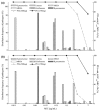Pharmacokinetics and pharmacodynamics of levofloxacin injection in healthy Chinese volunteers and dosing regimen optimization
- PMID: 23701411
- PMCID: PMC4285945
- DOI: 10.1111/jcpt.12074
Pharmacokinetics and pharmacodynamics of levofloxacin injection in healthy Chinese volunteers and dosing regimen optimization
Abstract
What is known and objective: The pharmacokinetics (PK) and pharmacodynamics (PD) of levofloxacin were investigated following administration of levofloxacin injection in healthy Chinese volunteers for optimizing dosing regimen.
Methods: The PK study included single-dose (750 mg/150 mL) and multiple-dose (750 mg/150 mL once daily for 7 days) phases. The concentration of levofloxacin in blood and urine was determined using HPLC method. Both non-compartmental and compartmental analyses were performed to estimate PK parameters. Taking fC(max) /MIC ≥5 and fAUC(24 h) /MIC ≥30 as a target, the cumulative fraction of response (CFR) of levofloxacin 750 mg for treatment of community-acquired pneumonia (CAP) was calculated using Monte Carlo simulation. The probability of target attainment (PTA) of levofloxacin at various minimal inhibitory concentrations (MICs) was also evaluated.
Results and discussion: The results of PK study showed that the C(max) and AUC(0-∞) of levofloxacin were 14·94 μg/mL and 80·14 μg h/mL following single-dose infusion of levofloxacin. The half-life and average cumulative urine excretion ratio within 72 h post-dosing were 7·75 h and 86·95%, respectively. The mean C(ss,max), C(ss,min) and AUC(0-τ) of levofloxacin at steady state following multiple doses were 13·31 μg/mL, 0·031 μg/mL and 103·7 μg h/mL, respectively. The accumulation coefficient was 1·22. PK/PD analysis revealed that the CFR value of levofloxacin 750-mg regimen against Streptococcus pneumoniae was 96·2% and 95·4%, respectively, in terms of fC(max) /MIC and fAUC/MIC targets.
What is new and conclusion: The regimen of 750-mg levofloxacin once daily provides a satisfactory PK/PD profile against the main pathogenic bacteria of CAP, which implies promising clinical and bacteriological efficacy for patients with CAP. A large-scale clinical study is warranted to confirm these results.
Keywords: Monte Carlo simulation; healthy volunteer; levofloxacin; pharmacodynamics; pharmacokinetics.
© 2013 John Wiley & Sons Ltd.
Figures



Similar articles
-
[Study of pharmacokinetics/pharmacodynamics of levofloxacin].Zhonghua Yi Xue Za Zhi. 2005 Jul 20;85(27):1926-32. Zhonghua Yi Xue Za Zhi. 2005. PMID: 16255991 Chinese.
-
Pharmacokinetics and Pharmacodynamics of Levornidazole in Patients With Intra-abdominal AnaerobicInfection.Clin Ther. 2018 Sep;40(9):1548-1555. doi: 10.1016/j.clinthera.2018.07.017. Epub 2018 Aug 23. Clin Ther. 2018. PMID: 30146271 Clinical Trial.
-
Population Pharmacokinetics and Pharmacodynamics Modeling of Oral Levofloxacin.J Med Assoc Thai. 2018 Aug;99(8):886-92. J Med Assoc Thai. 2018. PMID: 29947489
-
Intravenous Antibiotic and Antifungal Agent Pharmacokinetic-Pharmacodynamic Dosing in Adults with Severe Burn Injury.Clin Ther. 2016 Sep;38(9):2016-31. doi: 10.1016/j.clinthera.2016.08.001. Epub 2016 Aug 30. Clin Ther. 2016. PMID: 27586127 Review.
-
Pharmacokinetic/pharmacodynamic-based optimization of levofloxacin administration in the treatment of MDR-TB.J Antimicrob Chemother. 2016 Oct;71(10):2691-703. doi: 10.1093/jac/dkw164. Epub 2016 May 26. J Antimicrob Chemother. 2016. PMID: 27231277 Review.
Cited by
-
Harnessing ultrasound-stimulated phase change contrast agents to improve antibiotic efficacy against methicillin-resistant Staphylococcus aureus biofilms.Biofilm. 2021 May 11;3:100049. doi: 10.1016/j.bioflm.2021.100049. eCollection 2021 Dec. Biofilm. 2021. PMID: 34124645 Free PMC article.
-
Pharmacokinetic and Pharmacodynamic Properties of Rosmarinic Acid in Rat Cholestatic Liver Injury.Molecules. 2018 Sep 7;23(9):2287. doi: 10.3390/molecules23092287. Molecules. 2018. PMID: 30205454 Free PMC article.
-
Integrative population pharmacokinetic/pharmacodynamic analysis of nemonoxacin capsule in Chinese patients with community-acquired pneumonia.Front Pharmacol. 2023 Feb 28;14:912962. doi: 10.3389/fphar.2023.912962. eCollection 2023. Front Pharmacol. 2023. PMID: 36923351 Free PMC article.
-
Physicochemical Characteristics of Antimicrobials and Practical Recommendations for Intravenous Administration: A Systematic Review.Antibiotics (Basel). 2023 Aug 19;12(8):1338. doi: 10.3390/antibiotics12081338. Antibiotics (Basel). 2023. PMID: 37627758 Free PMC article. Review.
-
Pharmacokinetics and pharmacodynamics of multiple-dose intravenous nemonoxacin in healthy Chinese volunteers.Antimicrob Agents Chemother. 2015 Mar;59(3):1446-54. doi: 10.1128/AAC.04039-14. Epub 2014 Dec 22. Antimicrob Agents Chemother. 2015. PMID: 25534726 Free PMC article. Clinical Trial.
References
-
- Wang F, Zhang Y, editors. Practical antimicrobial therapeutics. Beijing: People's Medical Publishing House; 2004.
-
- Friedman H, Song X, Crespi S, Navaratnam P. Comparative analysis of length of stay, total costs, and treatment success between intravenous moxifloxacin 400 mg and levofloxacin 750 mg among hospitalized patients with community-acquired pneumonia. Value Health. 2009;12:1135–1143. - PubMed
-
- Frei CR, Jaso TC, Mortensen EM, et al. Medical resource utilization among community-acquired pneumonia patients initially treated with levofloxacin 750 mg daily versus ceftriaxone 1000 mg plus azithromycin 500 mg daily: a US-based study. Curr Med Res Opin. 2009;25:859–868. - PubMed
-
- Schein J, Janagap-Benson C, Grant R, Sikirica V, Doshi D, Olson W. A comparison of levofloxacin and moxifloxacin use in hospitalized community-acquired pneumonia (CAP) patients in the US: focus on length of stay. Curr Med Res Opin. 2008;24:895–906. - PubMed
-
- Lynch JP, 3rd, File TM, Jr, Zhanel GG. Levofloxacin for the treatment of community-acquired pneumonia. Expert Rev Anti Infect Ther. 2006;4:725–742. - PubMed
Publication types
MeSH terms
Substances
LinkOut - more resources
Full Text Sources
Other Literature Sources
Medical
Miscellaneous

